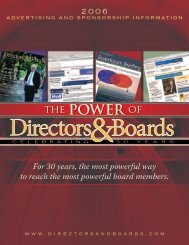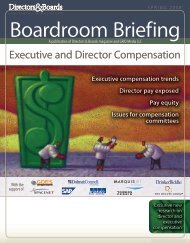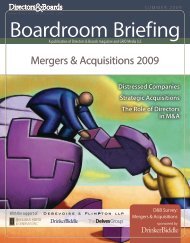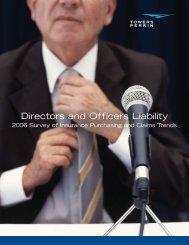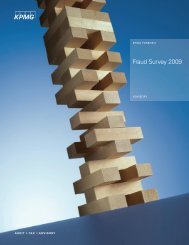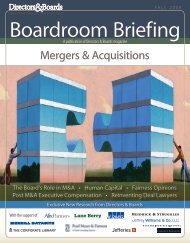The LRN ethics and compliance risk management practices report
The LRN ethics and compliance risk management practices report
The LRN ethics and compliance risk management practices report
You also want an ePaper? Increase the reach of your titles
YUMPU automatically turns print PDFs into web optimized ePapers that Google loves.
DETAILED RESULTS<br />
terms of budget <strong>and</strong> staff to drive their <strong>ethics</strong> <strong>and</strong> <strong>compliance</strong> education <strong>and</strong> certification<br />
programs. This result may be reflected in why companies employ less classroom education,<br />
interactive workshops or site visits than other types of prevention programs that require<br />
fewer resources. It may also relate to why companies are not reaching their business<br />
ecosystem <strong>and</strong> why global companies face greater challenges at their international locations<br />
than headquarters. <strong>The</strong> antidote to this finding is for <strong>ethics</strong> <strong>and</strong> <strong>compliance</strong> functions to<br />
reach out to other departments within the organization to enlist their support for quality<br />
prevention programs.<br />
Making education relevant <strong>and</strong> low employee engagement / motivation are<br />
significant secondary challenges.<br />
<strong>The</strong> challenges related to making education relevant <strong>and</strong> combating low employee<br />
engagement <strong>and</strong> interest will be critical issues of the future, especially as more Millennial<br />
generation workers join the workforce <strong>and</strong> blend with the current generation of boomers<br />
whose learning <strong>and</strong> work styles are different. Companies will likely need to alter the<br />
methods they most often use to appeal to this generation.<br />
orting Methods for Global Companies<br />
ds for Global Companies<br />
Increased globalization accounts for several other key challenges: cultural <strong>and</strong> regulatory<br />
differences as well as translations of <strong>ethics</strong> <strong>and</strong> <strong>compliance</strong> materials. <strong>The</strong> lack of resources<br />
may be at issue behind this gap, but regardless, companies will need to gain ground to<br />
ensure they educate all relevant employee groups, regardless of cultural or educational<br />
background, language spoken, or location.<br />
DETECT<br />
11. What are the methods you provide for employees <strong>and</strong> others to <strong>report</strong> <strong>ethics</strong> or<br />
<strong>compliance</strong> violations<br />
Almost 9 in 10 companies offer multiple means for <strong>report</strong>ing potential <strong>ethics</strong> or<br />
<strong>compliance</strong> violations.<br />
Reporting Methods Available to the Workforce<br />
Reporting Methods Available to the Workforce<br />
% Respondents<br />
% Respondents<br />
0% 20% 40% 60% 80% 100%<br />
0% 20% 40% 60% 80% 100%<br />
First Reporting Channel<br />
First Reporting Channel<br />
Supervisor<br />
Supervisor 93%<br />
Human Resources<br />
Human Resources 92%<br />
Anonymous/Confidential Reporting Channel<br />
Anonymous/Confidential Reporting Channel 91%<br />
Ethics & Compliance Office<br />
Ethics & Compliance Office 88%<br />
Legal Department<br />
Legal Department 86%<br />
Internal Ombudsman<br />
Internal Ombudsman 40%<br />
No set policy<br />
No set policy 17%<br />
93%<br />
92%<br />
91%<br />
88%<br />
86%<br />
40%<br />
17%<br />
% Respondents<br />
% Respondents<br />
10% 20% 30% 40% 50%<br />
% 20% 30% 40% 50%<br />
<strong>LRN</strong> | 2008 Ethics <strong>and</strong> Compliance Risk Management Practices Report | 31<br />
Reporting Methods for Global Companies<br />
Reporting Methods for Global Companies



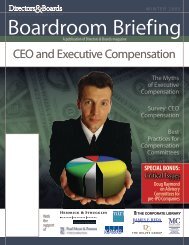
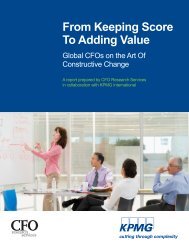
![[link to PDF] for a copy of the briefing paper - Directors & Boards](https://img.yumpu.com/43729022/1/190x245/link-to-pdf-for-a-copy-of-the-briefing-paper-directors-boards.jpg?quality=85)
